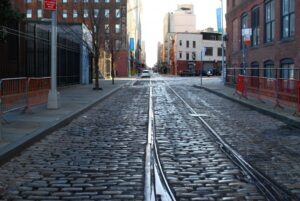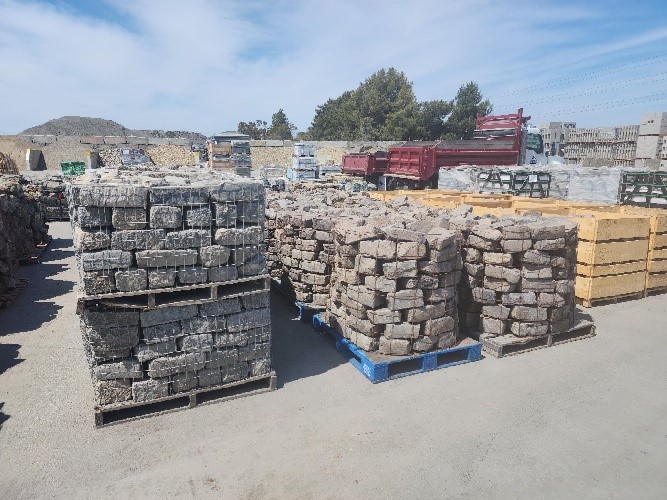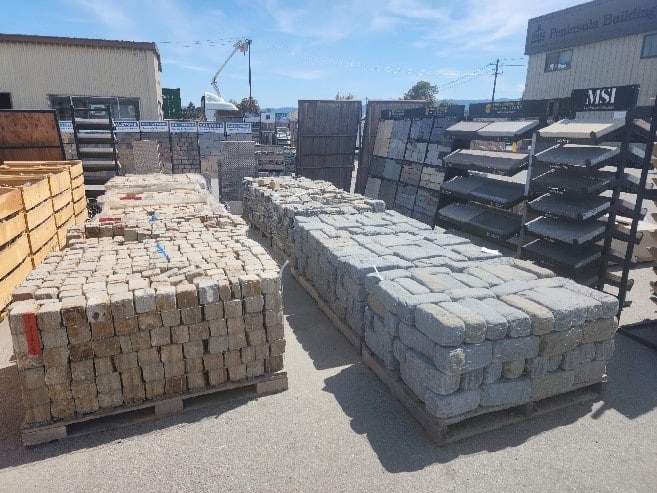San Francisco cobblestone streets—charming and chiseled with history. These days precast pavers are popular for driveways. But if you’re looking for natural cobblestones, like granite or basalt or porphyry, then not only can we help you find the right material, but we’d like to share the rich history of these regal stones.

What we see now in San Francisco are mainly cobblestone restorations, not original installations. But long ago, when gold flakes flickered in rivers and families trekked for months in covered wagons on nothing more than rumors of a better life, then San Francisco didn’t even know what cobblestones were. Back then there was no paving. No asphalt, no stones, not even wood. Just dirt paths, furrows and ruts. All this as the unplanned town of San Francisco kept exploding in size by the month.
Before paving caught on, private citizens and small business owners tossed crates and branches onto the mud. When that sank far enough they threw down more. Eventually city officials got together and made a plan, mainly out of concern for the horses pulling supplies, not the people. First came Douglas Fir planks. When the weather and horses chewed through those, Macadam and other bituminous materials were tried. But the local San Francisco weather made these substances unsustainable. Enter a more durable alternative: stones.

Quarries sprouted up near railroad lines and rivers. Teams of men breaking stones. Smooth round rocks from the American River dotted San Francisco streets. But the horses hauling carts up hills didn’t appreciate awkward mounds. And even on flat land the noise was so loud that residents complained about the endless clip-clopping. Around this time came a wave of Italian immigrants bringing with them the old world skills of rock forming and masonry. From today’s Marin County they began harvesting hard stones like granite and basalt, chiseling small blocks into five inch by five inch squares that became the first cobblestone streets in booming San Francisco. Everything looked great for about year. Then installations began sinking in the boggy subsoil.
Imagine you put in a cobblestone driveway apron and half of it gets eaten by dirt a year later. You’d likely call the contractor with choice words to share. But back during the gold rush there were no laws in place to protect citizens from faulty installations. Everyone was figuring it out together as they went. It took years to learn how to prepare the base to keep the stones from going under. All the while these experiments in paving were funded by private citizens and businesses, a standard law from that time levying financial responsibility on whomever was nearest the street. When asphalt was finally refined enough to withstand San Francisco weather, builders began laying it directly over cobblestones to save time and money. Years of this.
As workers dig up streets today to service underground lines, or builders excavate preparing for skyscrapers, stories are found buried everywhere. Original granite and basalt pavers are reclaimed and either laid for new city projects or sold to homeowners looking for authentic cobblestone driveways. What is the cost of an authentic cobblestone driveway you say? Not cheap. Fortunately we here at PBM have plenty of cobblestones in stock that did not come from the buried depths of gold rush times—a little easier on the wallet with just as much charm.


History, resilience, and unparalleled aesthetic—that’s what you get with natural cobblestone pavers. For those entertaining the idea remember how lucky you are to be installing cobblestones today and not way back when. And if you need help picturing your options, come down to our Redwood City yard and look for yourself.



